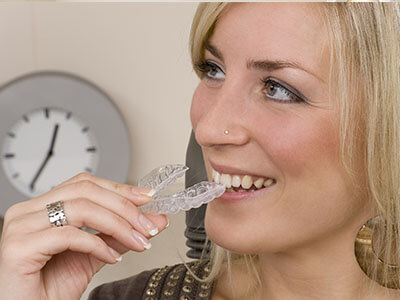
Our Office
Visit Us Online

Invisalign® offers a discreet, modern alternative to traditional braces, letting many adults and teens straighten teeth with clear, removable aligners. Designed to fit into everyday life, this approach combines digital planning and custom fabrication so you can pursue a healthier, more confident smile without the appearance or restrictions of metal appliances.
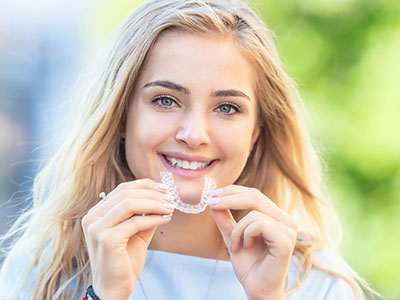
Invisalign® for Teens

Invisalign® for Brides

Invisalign® for Travelers
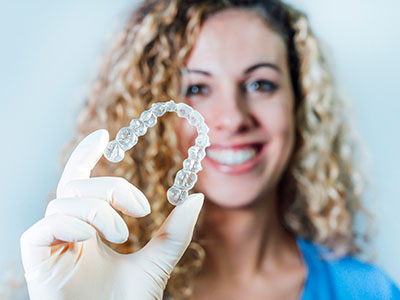
Before & After Photos
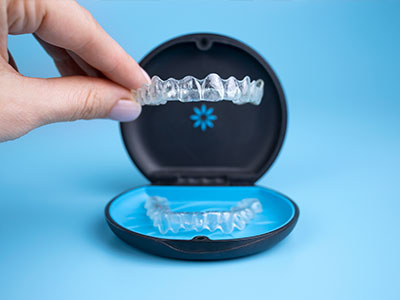
Invisalign® Videos
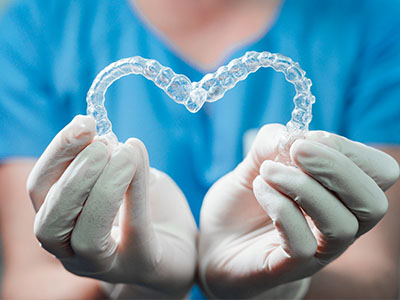
FAQs
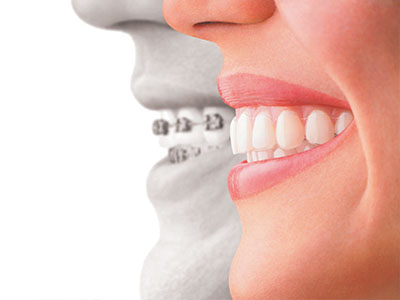
Invisalign® vs Braces
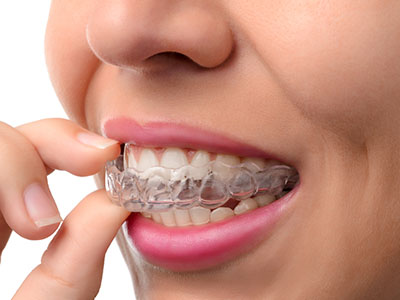
Invisalign® vs Direct-To-Consumer Aligners
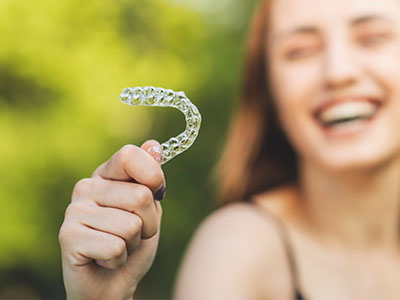
Is Invisalign® Right For Me?
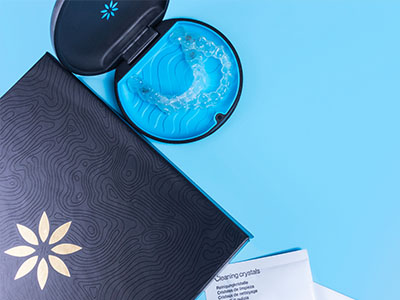
Invisalign® Costs
Clear aligners are popular because they minimize the visible impact of orthodontic treatment while still delivering predictable tooth movement. Instead of brackets and wires, the system uses a series of graduated, transparent trays that apply gentle, controlled force to shift teeth into the desired positions. That subtle approach makes it easier for patients to feel comfortable at work, school, or social events during treatment.
Beyond aesthetics, the removable nature of aligners simplifies daily oral care. Patients can take them out to eat, brush, and floss, which helps maintain gum health and reduces the risk of decay that can sometimes accompany fixed appliances. For people who value convenience and oral hygiene, that freedom is one of the biggest practical advantages.
Clinically, clear aligner therapy has evolved to address a wide range of alignment and bite issues. Many common concerns—such as crowding, spacing, mild to moderate bite irregularities, and certain rotational corrections—can be managed effectively with carefully planned aligner sequences, making them a versatile tool in contemporary orthodontics.
Treatment begins with a detailed evaluation and a fast, accurate digital scan of the teeth. These high-resolution images replace the messy impression trays of the past and provide a precise 3-D model that serves as the foundation for the entire plan. Using specialized software, the clinician can map out a step-by-step progression of tooth movements and visualize the projected outcomes.
From that digital model, a customized series of clear aligners is manufactured to match each planned stage. Each aligner is worn for a set period—typically a week or two—before switching to the next in the sequence. Because the plan is mapped from start to finish, both patient and provider can review the anticipated changes before treatment begins.
Throughout planning, the dental team considers the functional needs of the bite as well as esthetic goals. That means the focus is not only on straightening teeth but also on achieving a stable, comfortable jaw relationship and a smile that fits the patient's facial features.
Wearing aligners consistently is essential for progress. Most clinicians recommend wearing aligners for about 20–22 hours per day, removing them only for meals and oral hygiene. Early on, some patients experience mild pressure or soreness when switching to a new tray—this sensation signals that the aligners are guiding the teeth forward and usually eases within a few days.
Routine checkups are an important part of success. Appointments typically occur every four to eight weeks so the clinician can monitor movement, address any fit issues, and provide the next set of aligners. These visits are generally shorter and less invasive than many traditional orthodontic appointments because there are no wires to adjust.
Compliance and communication make a big difference in outcomes. Following wear-time recommendations, keeping aligners clean, and reporting any unexpected concerns promptly helps maintain momentum and reduces the likelihood of delays or refinements later in the process.
Clear aligners are a strong option for many adults and teens who have mild to moderate alignment or bite issues. People seeking a discreet solution, those with established oral hygiene routines, and patients who want minimal impact on daily activities are often good candidates. Because aligner trays are removable, they also appeal to those who prioritize the ability to eat and clean their teeth without obstruction.
That said, every smile is unique. Complex orthodontic challenges—severe skeletal discrepancies, certain types of tooth rotations, or significant bite corrections—may require adjunctive treatments or a different approach. During an initial consultation, clinicians evaluate dental and skeletal relationships, tooth movement needs, and overall oral health to determine whether aligner therapy alone will meet the patient’s goals.
Age is less important than dental development and oral health. Teen patients who have lost most primary teeth and have ongoing growth patterns can successfully use aligners when supervised appropriately, while many adults find aligners an attractive route to achieve long-awaited improvements.
Proper care of aligners and teeth supports both comfort and final outcomes. Clean aligners regularly with recommended solutions and gently brush and rinse them to prevent buildup. Maintaining a consistent brushing and flossing routine ensures the teeth and gums remain healthy as they move—this is critical, because inflamed gums or untreated decay can interfere with treatment and overall oral health.
After the active phase, wearing a retainer as directed preserves the new tooth positions. Retention strategies vary by case but commonly include removable retainers used nightly or indefinitely to prevent relapse. Your dental team will recommend a retention protocol tailored to the specifics of your treatment and long-term goals.
Follow-up visits let your clinician assess stability and suggest adjustments if minor settling occurs. With sensible maintenance and periodic checkups, most patients enjoy the benefits of a straighter, healthier smile long after the last aligner is removed.

A focused exam helps identify your priorities and determines whether aligners are the best route. This visit sets the expectations and outlines next steps.
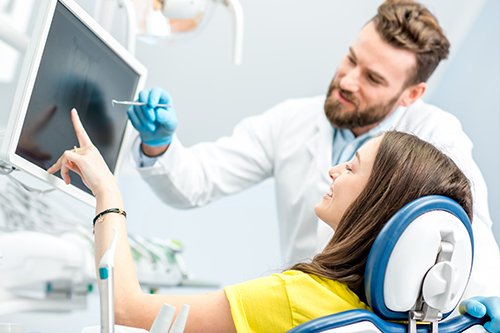
Before fabrication, a digital preview often shows the planned progression so you can see how your smile may change over time.
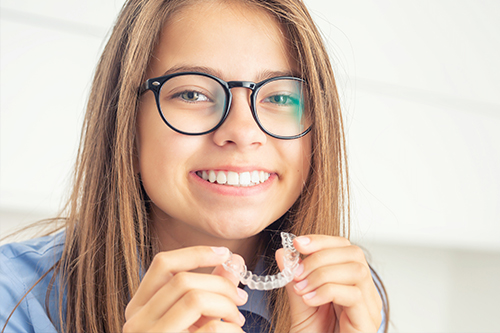
Each aligner is produced to precise specifications so movements occur in a controlled, stepwise fashion focused on comfort and effectiveness.

From initial delivery through retention, regular touchpoints ensure treatment stays on track and that any questions are addressed promptly.
*Invisalign® is a registered trademark of Align Technology, Inc.
At Frankford Dental Group, we combine modern orthodontic options with personalized care to help patients pursue confident, healthy smiles. If you’re curious about whether clear aligner therapy could be right for you, contact us for more information and to schedule a consultation.
There are many options for patients who want to avoid metal braces! The most popular alternative orthodontic treatment is Invisalign®, which are clear plastic aligners designed to straighten teeth. After an examination of your teeth, your dentist will determine which option is best suited to your wants and needs.
According to the Invisalign® website, the cost for treatment is approximately the same as the cost for metal braces. A portion of this cost may be covered by your insurance. Please call us to set up a consultation and discuss potential payment plan options.
The first step is to schedule a consultation with your doctor, so they can devise a treatment plan that is best suited to your individual dental needs. Once approved, you will receive your first set of aligners. Your doctor will then regularly monitor the movement of your teeth and new aligners will be ordered according to the progress made in your treatment plan.
Invisalign® aligners are made of clear, flexible plastic. The company received a patent for this material – SmartTrack® – to be used exclusively for Invisalign treatment purposes. These aligners are FDA approved and nearly invisible!
Your doctor will give you an estimate regarding how long your Invisalign® treatment should take, which will depend on your specific needs. The average length of time for treatment is approximately 12-18 months. However, some patients may see results far sooner. Remember to wear your aligners exactly as instructed by your doctor to obtain the best results.
Your doctor will most likely recommend that you wear retainers following your Invisalign® treatment. This is a precaution that will prevent your teeth from shifting back to their original positioning. It is important to follow your doctor's instructions exactly to ensure long-lasting results.
You must wear your aligners for up to 22 hours daily. You may remove them for eating, drinking and regular oral hygiene.
No. Unlike braces, you may eat whatever you like as long as you remove the aligners before eating. Prior to placing the aligners back on, it is important to brush your teeth and the aligners after you eat.
Like any orthodontic treatment, there is a short adjustment period. The more you speak with the aligners on, the quicker you will adjust.
There will be some pressure and minor discomfort for a day or two after each initial insertion. This is a sign that your teeth are moving sequentially into their final position.
It is recommended that you remove your aligners prior to chewing gum as the gum will stick to the aligners.
We discourage smoking with aligners as the cigarette smoke will tend to discolor them.
Brushing them with toothpaste will keep them fresh and clean.
Regular office visits are every five to six weeks. This will ensure that your Invisalign treatment is progressing as planned.
All orthodontic patients are instructed to wear their retainers at night indefinitely. Sleeping with your retainers in at night will ensure a healthy bite and maintain the new position of your teeth.
Yes, if their teeth, including second molars, have grown in completely.
Invisalign® is a clear aligner system that straightens teeth using a series of custom-made, removable trays. Treatment begins with a detailed digital scan that creates a 3-D model of the teeth and a step-by-step plan for movement. Each aligner applies gentle, controlled force to specific teeth and is worn for a set period before progressing to the next tray.
The digital planning process lets clinicians visualize projected outcomes and make adjustments before fabrication. Because the trays are removable, patients can maintain regular oral hygiene and eat without the constraints of fixed appliances. Regular monitoring by the dental team ensures the plan is progressing as expected and allows for refinements if needed.
Adults and teens with mild to moderate alignment or bite issues are often good candidates for Invisalign® therapy. Candidates should have good overall oral health, with untreated decay or active gum disease addressed before treatment begins. For teen patients, adequate dental development and responsible compliance are important factors that the clinician will evaluate.
Complex skeletal problems and certain severe tooth rotations may require alternative or adjunctive treatment, so a clinical assessment is necessary to determine suitability. The dentist will review dental and skeletal relationships, document goals, and recommend whether aligners alone are appropriate or if combined therapy is indicated. Individualized planning ensures the chosen approach meets both functional and esthetic objectives.
Treatment typically starts with a consultation, clinical exam, and a fast digital scan of the teeth to create an accurate 3-D model. Using specialized software, the clinician maps tooth movements and produces a visual treatment plan that shows the expected progression. Once the plan is approved, a customized series of aligners is fabricated to match each stage of movement.
Patients wear each aligner for the prescribed time—usually about one to two weeks—before switching to the next in the sequence. Periodic appointments allow the dental team to monitor progress and provide subsequent aligners; adjustments or refinements may be made if movements differ from the original plan. The goal is to achieve a stable, functional result that complements facial features and occlusion.
Clean aligners daily using lukewarm water and a soft brush or the cleaning method recommended by your provider; avoid hot water that can warp plastic. Rinse aligners before reinserting them and store them in a protective case when not in use to prevent damage or contamination. Regularly inspect trays for fit and cleanliness, and report any persistent odor or discoloration to your dental team.
Maintain a consistent routine of brushing twice daily and flossing once daily to support gum health and prevent decay while teeth move. Remove aligners for eating and drinking anything other than water to reduce staining and maintain hygiene. Keeping teeth and aligners clean supports comfort and helps treatment proceed without unnecessary interruption.
Follow-up visits are commonly scheduled every four to eight weeks so the clinician can assess tooth movement and address fit or attachment issues. These appointments are generally shorter than many traditional orthodontic visits because there are no wires to adjust, but they remain essential for tracking progress. During these visits, the team may deliver new aligners, evaluate oral health, and make minor corrections as needed.
The exact frequency of appointments depends on the treatment complexity and the clinician’s protocol, and remote monitoring tools may supplement in-office checks for certain cases. If aligners feel ill-fitting or if any dental concerns arise, contacting the office promptly helps prevent delays. Consistent attendance at scheduled visits contributes to predictable, efficient results.
Invisalign® can effectively address many alignment and bite concerns, including crowding, spacing, and a range of mild to moderate malocclusions. Modern aligner systems incorporate features such as attachments, precision cuts, and auxiliaries like elastics to manage more challenging movements than earlier versions could. For many patients, these enhancements expand the scope of cases that can be treated without traditional braces.
Severe skeletal discrepancies, significant jaw asymmetry, or certain complex rotations may still require alternative approaches or combined therapies such as braces with surgical treatment. The clinician evaluates each case to determine whether aligner therapy alone will meet the goals or if adjunctive procedures are needed. A comprehensive exam and treatment plan will outline the recommended path and expected outcomes.
Many patients notice a mild change in speech, such as a temporary lisp, when they first begin wearing aligners, but this typically resolves within a few days as the tongue adapts. Aligners are made from smooth, thin plastic designed for comfort, and most people acclimate quickly to wearing them during daily activities. Initial soreness or pressure when switching to a new tray is common and is a normal sign of tooth movement.
Discomfort usually subsides within a few days and can be managed with over-the-counter analgesics if needed and guidance from the dental team. If an aligner edge irritates soft tissues, the clinician can trim or adjust it to improve comfort. Prompt communication about persistent pain or fit problems helps ensure timely solutions and uninterrupted progress.
Alternatives include conventional metal braces, ceramic braces, lingual braces placed on the tongue side of teeth, and other clear aligner brands; each option has different clinical strengths and lifestyle considerations. Fixed braces may offer more precise control for certain tooth movements, while lingual braces provide an invisible option but can affect speech and hygiene differently. The choice depends on the nature of the malocclusion, patient preferences, hygiene capabilities, and the clinician’s clinical judgment.
A thorough consultation compares the expected outcomes, treatment timelines, and practical implications of each approach without relying on cost considerations. Your dental professional will explain which options are clinically appropriate and why, helping you select the solution that best aligns with functional needs and personal priorities. In many cases, the final recommendation balances effectiveness with comfort and daily life compatibility.
Retention is a critical phase that preserves the new tooth positions after active alignment, and most patients receive a retainer tailored to their needs. Retainers can be removable or fixed and are typically worn nightly or according to a schedule the clinician prescribes. Adhering to the recommended retention protocol reduces the risk of relapse and helps stabilize occlusion over time.
Periodic follow-up visits allow the dental team to monitor stability and suggest adjustments if minor settling occurs. Good oral hygiene and routine dental checkups support long-term health and the longevity of the result. The retention plan will be individualized based on the specifics of the case and long-term goals.
At Frankford Dental Group we begin with a focused consultation that includes a clinical exam, a review of dental and medical history, and a digital scan or x-rays as needed to document the starting condition. During this visit the clinician discusses treatment goals, reviews the projected outcomes, and explains any recommended adjunctive steps to optimize results. This appointment sets clear expectations and outlines the next steps in the process.
Our office is located at 5730 66th St., Lubbock, TX 79424, and the team will explain scheduling, clinical requirements, and what to anticipate during active treatment and retention. If aligner therapy is appropriate, you will receive a personalized plan and a timeline for care. Clear communication at the outset helps ensure a smooth treatment experience and supports predictable outcomes.
Available after hours by appointment.
